WordStream has come to be known mostly as a PPC destination. But we also know a thing or two about SEO, and people ask us all the time for a primer on SEO basics. So we’re delivering: This article will be an introduction and overview of search engine optimization (SEO), a mandatory marketing tactic if you want your website to be found through search engines like Google.
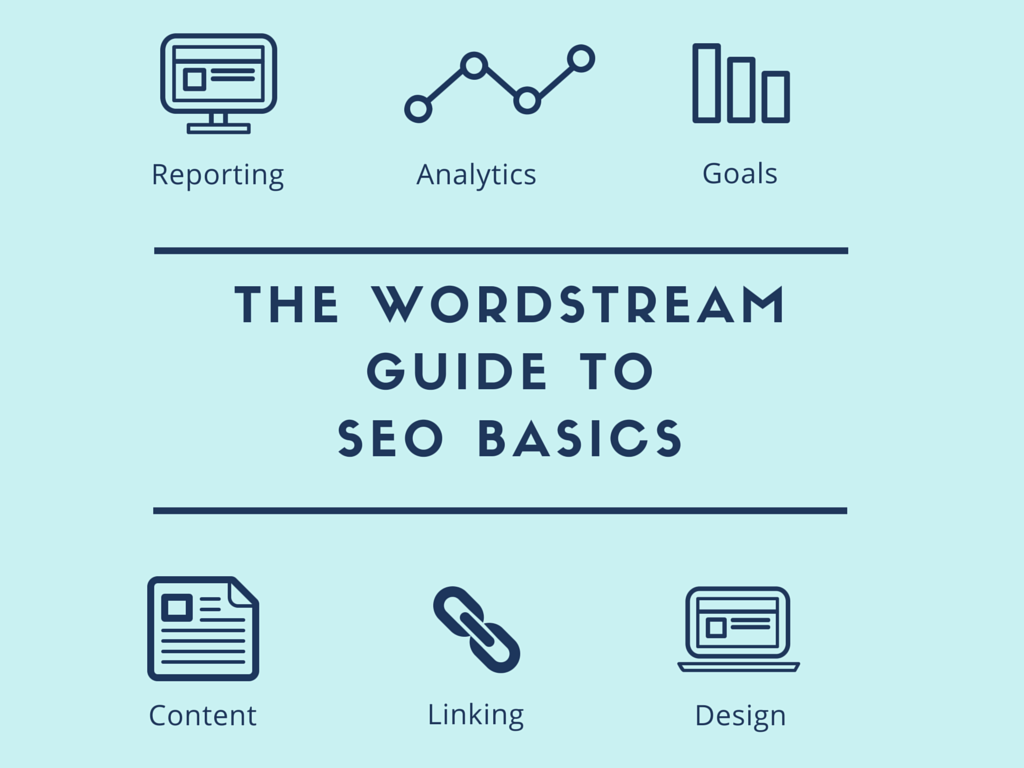
In this guide to SEO for beginners, you’ll learn:
- What is SEO and why is it important?
- Keyword research and keyword targeting
- On-page SEO optimization
- Information architecture
- Content marketing and link building
- Technical SEO
- How to track and measure SEO results
- Mobile, international, and local SEO
By the time you reach the end of this SEO basics guide, you’ll have a strong understanding of what search engine optimization is, why it’s valuable and important, and how to get great results in an ever-changing SEO environment.
SEO Basics Part 1: What is SEO and why is it important?
You’ve likely heard of SEO, and if you haven’t already, you could obtain a quick Wikipedia definition of the term, but understanding that SEO is “the process of affecting the visibility of a website or a web page in a search engine’s unpaid results” doesn’t really help you answer important questions for your business and your website, such as:
- How do you, for your site or your company’s site, “optimize” for search engines?
- How do you increase your site’s organic search visibility, so it’s easy for your content to be found?
- How do you know how much time to spend on SEO?
- How can you differentiate “good” SEO advice from “bad” or harmful SEO advice?
What’s likely interesting to you as a business owner or employee is how you can actually leverage SEO to help drive more relevant traffic, leads, sales, and ultimately revenue and profit for your business. That’s what we’ll focus on in this guide.
Free guide >> 25 Ways to Increase Traffic to Your Website
Why should you care about SEO?
Lots and lots of people search for things. That traffic can be extremely powerful for a business not only because there is a lot of traffic, but because there is a lot of very specific, high-intent traffic.
If you sell blue widgets, would you rather buy a billboard so anyone with a car in your area sees your ad (whether they will ever have any interest in blue widgets or not), or show up every time anyone in the world types “buy blue widgets” into a search engine? Probably the latter, because those people have commercial intent, meaning they are standing up and saying that they want to buy something you offer.
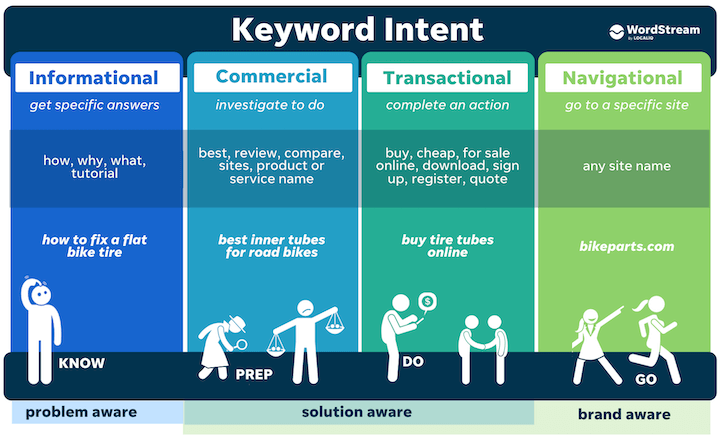
People are searching for any manner of things directly related to your business. Beyond that, your prospects are also searching for all kinds of things that are only loosely related to your business. These represent even more opportunities to connect with those folks and help answer their questions, solve their problems, and become a trusted resource for them.
Are you more likely to get your widgets from a trusted resource who offered great information each of the last four times you turned to Google for help with a problem, or someone you’ve never heard of?
What actually works for driving traffic from search engines?
First it’s important to note that Google is responsible for most of the search engine traffic in the world (though there is always some flux in the actual numbers). This may vary from niche to niche, but it’s likely that Google is the dominant player in the search results that your business or website would want to show up in, and the best practices outlined in this guide will help position your site and its content to rank in other search engines, as well.
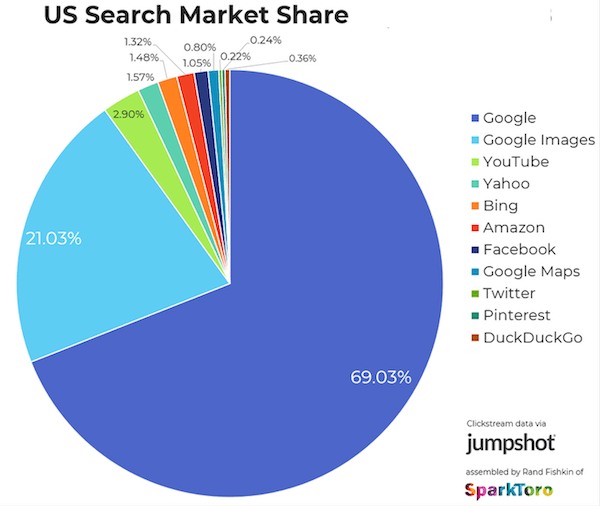
Regardless of what search engine you use, search results are constantly changing. Google particularly has updated lots of things surrounding how they rank websites by way of lots of different animal names recently, and a lot of the easiest and cheapest ways to get your pages to rank in search results have become extremely risky in recent years.
So what works? How does Google determine which pages to return in response to what people search for? How do you get all of this valuable traffic to your site?
Google’s algorithm is extremely complex, and I’ll share some links for anyone looking to dive deeper into how Google ranks sites at the end of this section, but at an extremely high level:
- Google is looking for pages that contain high-quality, relevant information about the searcher’s query.
- They determine relevance by “crawling” (or reading) your website’s content and evaluating (algorithmically) whether that content is relevant to what the searcher is looking for, mostly based on the keywords it contains.
- They determine “quality” by a number of means, but prominent among those is still the number and quality of other websites that link to your page and your site as a whole. To put it extremely simply: If the only sites that link to your blue widget site are blogs that no one else on the Web has linked to, and my blue widget site gets links from trusted places that are linked to frequently, like CNN.com, my site will be more trusted (and assumed to be higher quality) than yours.
Increasingly, additional elements are being weighed by Google’s algorithm to determine where your site will rank, such as:
- How people engage with your site (Do they find the information they need and stay on your site, or bounce back to the search page and click on another link? Or do they just ignore your listing in search results altogether and never click-through?)
- Your site’s loading speed and “mobile friendliness”
- How much unique content you have (versus very “thin” low-value content or duplicate content)
There are hundreds of ranking factors Google’s algorithm considers in response to searches, and they are constantly updating and refining their process.
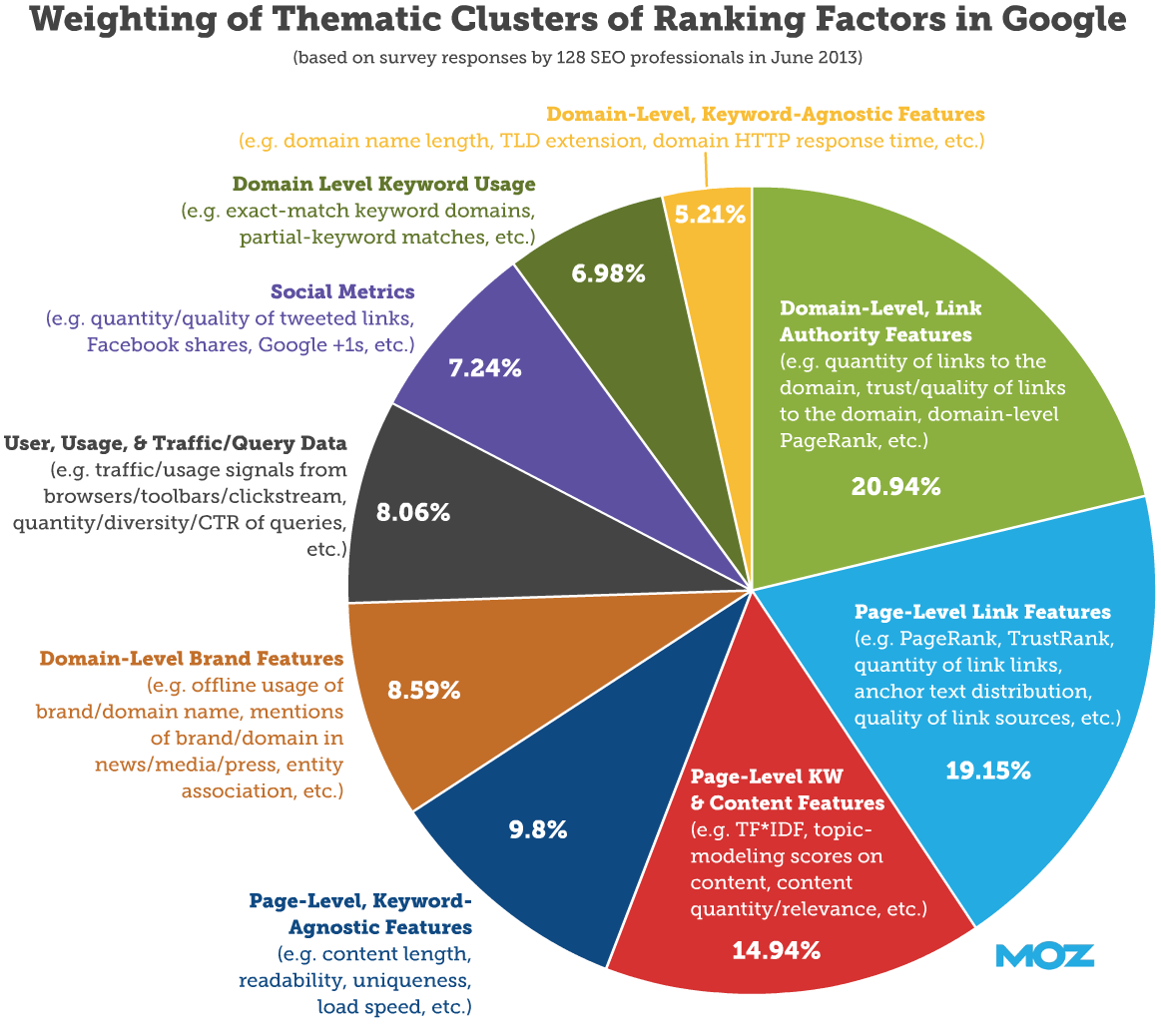
The good news is, you don’t have to be a search engine scholar to rank for valuable terms in search results. We’ll walk through proven, repeatable best practices for optimizing websites for search that can help you drive targeted traffic through search without having to reverse-engineer the core competency of one of the world’s most valuable companies.
If you’re interested in learning more about how search engines work, there are a ton of great resources available, including:
Now, back to SEO basics! Let’s get into the actual SEO tactics and strategies that will help you get more traffic from search engines.
Check your website against Google ranking factors with the free LOCALiQ Website Grader!
SEO Basics Part 2: Keyword research and keyword targeting best practices
The first step in search engine optimization is really to determine what it is you’re actually optimizing for. This means identifying the terms people are searching for (also known as “keywords”) that you want your website to rank for in search engines like Google.
Sounds simple enough, right? I want my widget company to show up when people look for “widgets,” and maybe when they type in things like “buy widgets.” Onto step three!

Unfortunately it’s not quite that simple. There are a few key factors to take into account when determining the keywords you want to target on your site:
- Search Volume – The first factor to consider is how many people (if any) are actually searching for a given keyword. The more people there are searching for a keyword, the bigger the audience you stand to reach. Conversely, if no one is searching for a keyword, there is no audience available to find your content through search.
- Relevance – If a term is frequently searched for that’s great: but what if it’s not completely relevant to your prospects? Relevance seems straightforward at first: if you’re selling enterprise email marketing automation software you don’t want to show up for searches that don’t have anything to do with your business, like “pet supplies.” But what about terms like “email marketing software”? This might intuitively seem like a great description of what you do, but if you’re selling to Fortune 100 companies, most of the traffic for this very competitive term will be searchers who don’t have any interest in buying your software (and the folks you do want to reach might never buy your expensive, complex solution based on a simple Google search). Conversely, you might think a tangential keyword like “best enterprise PPC marketing solutions” is totally irrelevant to your business since you don’t sell PPC marketing software. But if your prospect is a CMO or marketing director, getting in front of them with a helpful resource on evaluating pay-per-click tools could be a great “first touch” and an excellent way to start a relationship with a prospective buyer.
- Competition – As with any business opportunity, in SEO you want to consider the potential costs and likelihood of success. For SEO, this means understanding the relative competition (and likelihood to rank) for specific terms.
First you need to understand who your prospective customers are and what they’re likely to search for. If you don’t already understand who your prospects are, thinking about that is a good place to start, for your business in general but also for SEO.
From there you want to understand:
- What types of things are they interested in?
- What problems do they have?
- What type of language do they use to describe the things that they do, the tools that they use, etc.?
- Who else are they buying things from (this means your competitors, but also could mean tangential, related tools – for the email marketing company, think other enterprise marketing tools)?
Once you’ve answered these questions, you’ll have an initial “seed list” of possible keywords and domains to help you get additional keyword ideas and to put some search volume and competition metrics around.
Take the list of core ways that your prospects and customers describe what you do, and start to input those into keyword tools like Google’s own keyword tool or tools like Uber Suggest or WordStream’s keyword tool:
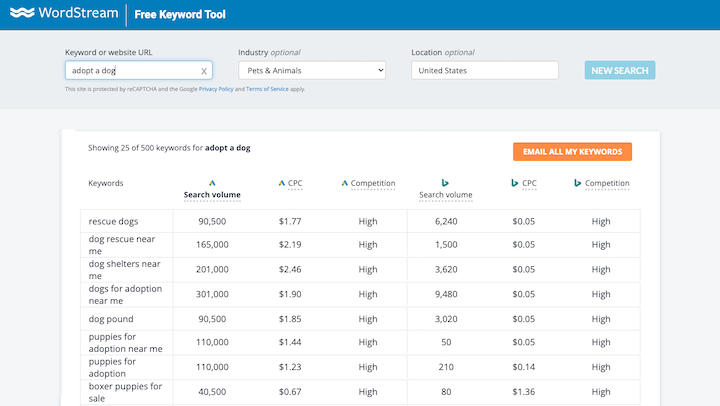
You can find a more comprehensive list of keyword tools below, but the main idea is that in this initial step, you’ll want to run a number of searches with a variety of different keyword tools. You can also use competitive keyword tools like SEM Rush to see what terms your competitors are ranking for. These tools look at thousands of different search results, and will show you each search term they’ve seen your competitor ranking in Google for lately. Here’s what SEM Rush shows for marketing automation provider Marketo:

Again: this doesn’t just have to be something you look at for competitors. You could look at related tools that are selling to the same market for content ideas, and even look at the major niche publishers who talk about your topic (and that your prospects are reading) and see what kinds of keywords those sites are driving traffic for.
Additionally, if you have an existing site, you’re likely getting some traffic from search engines already. If that’s the case, you can use some of your own keyword data to help you understand which terms are driving traffic (and which you might be able to rank a bit better for).
Unfortunately, Google has stopped delivering a lot of the information about what people are searching for to analytics providers, but you can use SEM Rush (or similar tools, such as SpyFu) on your own site to get a sense of the terms you’re ranking for and their estimated search volume. Google also makes a bit more of this data available in their free Google Search Console interface (if you haven’t set up an account, this is a very valuable SEO tool both for unearthing search query data and for diagnosing various technical SEO issues – more on Google Search Console here).
Once Google Search Console is set up, you can navigate to this link when logged in and see the search queries that are driving traffic to your site:
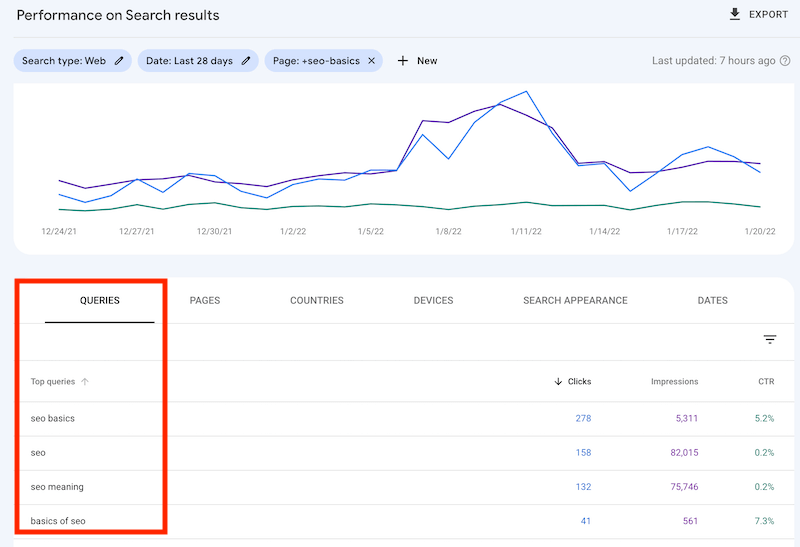
These could be good terms to focus additional content promotion and internal linking around (more on each of those topics later), and could also be great “seed keywords” to help you get more great ideas about what to target.
Once you’ve taken the time to understand how your prospects talk and what they search for, have looked at the keywords driving traffic to your competitors and related sites, and have looked at the terms driving traffic to your own site, you need to work to understand which terms you can conceivably rank for and where the best opportunities actually lie.
Determining the relative competition of a keyword can be a fairly complex task. At a very high level, you need to understand:
- How trusted and authoritative other entire sites that will be competing to rank for the same term are (in other words: how many links does the whole site get, and how high quality, trusted, and relevant are those linking sites?)
- How well aligned they are with the keyword itself (do they offer a great answer to that searcher’s question)
- How popular and authoritative each individual page in that search result is (in other words: how many links does the page itself have, and how high quality, trusted, and relevant are those linking sites?)
You can dive deeper into the process of determining how competitive keywords are in Backlinko’s in-depth guide or by using WordStream founder Larry Kim’s competitive index formula (tip number 3).
There are also a variety of different tools (most of them paid) that offer keyword difficulty scores:
- Moz Keyword Difficulty and SERP Analysis Tool
- SEMRush Keyword Difficulty Tool
- Serpiq
- Canirank
- Colibri.io
- Seoprofiler
- Ultimatenichefinder
- Advanced Webranking’s Keyword Difficulty Tool
And while it’s more advanced in nature, Nick Eubanks’ post about understanding rank potential offers a great in-depth look at not only understanding but creating an actionable formula for determining keyword competition and your own site’s actual likelihood of ranking for a term.
If you’re looking to dive even deeper into the topic of keyword research and keyword targeting, we have several great resources on the topic:
- WordStream’s The Big, Easy Guide to Keyword Research
- Moz has a great guide on this topic as well
- Backlinko’s definitive guide to keyword research is also thorough and extremely useful
SEO Basics Part 3: On-page optimization
Once you have your keyword list, the next step is actually implementing your targeted keywords into your site’s content. Each page on your site should be targeting a core term, and a “basket” of related terms. Here’s what a page optimized for on-page SEO looks like:
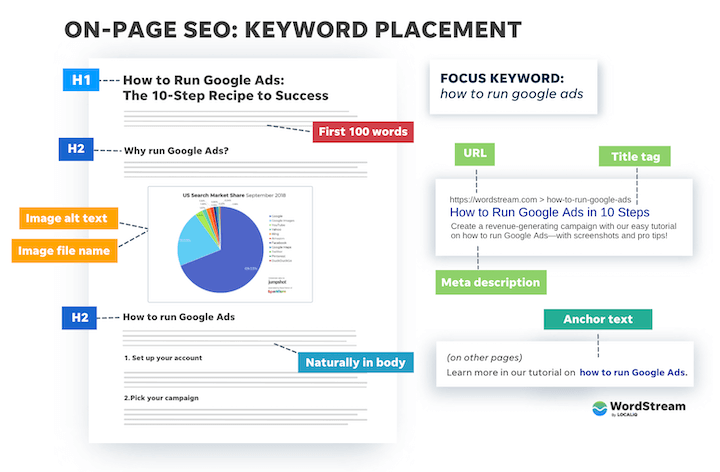
Learn more in our Complete, Visual Guide to On-Page SEO (With Templates!)
Let’s look at a few critical, basic on-page elements you’ll want to understand as you think about how to drive search engine traffic to your website:
Title tags
While Google is working to better understand the actual meaning of a page and de-emphasizing (and even punishing) aggressive and manipulative use of keywords, including the term (and related terms) that you want to rank for in your pages is still valuable. And the single most impactful place you can put your keyword is your page’s title tag.
The title tag is not your page’s primary headline. The headline you see on the page is typically an H1 (or possibly an H2) HTML element. The title tag is what you can see at the very top of your browser, and is populated by your page’s source code in a meta tag:
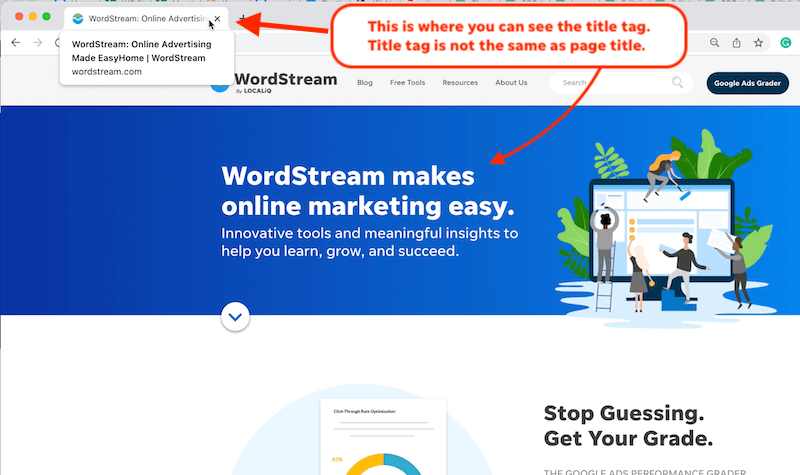
The length of a title tag that Google will show will vary (it’s based on pixels, not character counts) but in general 55-60 characters is a good rule of thumb here. If possible you want to work in your core keyword, and if you can do it in a natural and compelling way, add some related modifiers around that term as well. Keep in mind though: the title tag will frequently be what a searcher sees in search results for your page. It’s the “headline” in organic search results, so you also want to take how clickable your title tag is into account.
Meta descriptions
While the title tag is effectively your search listing’s headline, the meta description (another meta HTML element that can be updated in your site’s code, but isn’t seen on your actual page) is effectively your site’s additional ad copy. Google takes some liberties with what they display in search results, so your meta description may not always show, but if you have a compelling description of your page that would make folks searching likely to click, you can greatly increase traffic. (Remember: showing up in search results is just the first step! You still need to get searchers to come to your site, and then actually take the action you want.)
Here’s an example of a real world meta description showing in search results:

Body content
The actual content of your page itself is, of course, very important. Different types of pages will have different “jobs” – your cornerstone content asset that you want lots of folks to link to needs to be very different than your support content that you want to make sure your users find and get an answer from quickly. That said, Google has been increasingly favoring certain types of content, and as you build out any of the pages on your site, there are a few things to keep in mind:
- Thick and Unique Content – There is no magic number in terms of word count, and if you have a few pages of content on your site with a handful to a couple hundred words you won’t be falling out of Google’s good graces, but in general recent Panda updates in particular favor longer, unique content. If you have a large number (think thousands) of extremely short (50-200 words of content) pages or lots of duplicated content where nothing changes but the page’s title tag and say a line of text, that could get you in trouble. Look at the entirety of your site: are a large percentage of your pages thin, duplicated and low value? If so, try to identify a way to “thicken” those pages, or check your analytics to see how much traffic they’re getting, and simply exclude them (using a noindex meta tag) from search results to keep from having it appear to Google that you’re trying to flood their index with lots of low value pages in an attempt to have them rank.
- Engagement – Google is increasingly weighting engagement and user experience metrics more heavily. You can impact this by making sure your content answers the questions searchers are asking so that they’re likely to stay on your page and engage with your content. Make sure your pages load quickly and don’t have design elements (such as overly aggressive ads above the content) that would be likely to turn searchers off and send them away.
- “Sharability” – Not every single piece of content on your site will be linked to and shared hundreds of times. But in the same way you want to be careful of not rolling out large quantities of pages that have thin content, you want to consider who would be likely to share and link to new pages you’re creating on your site before you roll them out. Having large quantities of pages that aren’t likely to be shared or linked to doesn’t position those pages to rank well in search results, and doesn’t help to create a good picture of your site as a whole for search engines, either.
Alt attributes
How you mark up your images can impact not only the way that search engines perceive your page, but also how much search traffic from image search your site generates. An alt attribute is an HTML element that allows you to provide alternative information for an image if a user can’t view it. Your images may break over time (files get deleted, users have difficulty connecting to your site, etc.) so having a useful description of the image can be helpful from an overall usability perspective. This also gives you another opportunity – outside of your content – to help search engines understand what your page is about.
You don’t want to “keyword stuff” and cram your core keyword and every possible variation of it into your alt attribute. In fact, if it doesn’t fit naturally into the description, don’t include your target keyword here at all. Just be sure not to skip the alt attribute, and try to give a thorough, accurate description of the image (imagine you’re describing it to someone who can’t see it – that’s what it’s there for!).
By writing naturally about your topic, you’re avoiding “over-optimization” filters (in other words: it doesn’t make it look like you’re trying to trick Google into ranking your page for your target keyword) and you give yourself a better chance to rank for valuable modified “long tail” variations of your core topic.
URL structure
Your site’s URL structure can be important both from a tracking perspective (you can more easily segment data in reports using a segmented, logical URL structure), and a shareability standpoint (shorter, descriptive URLs are easier to copy and paste and tend to get mistakenly cut off less frequently). Again: don’t work to cram in as many keywords as possible; create a short, descriptive URL.
Moreover: if you don’t have to, don’t change your URLs. Even if your URLs aren’t “pretty,” if you don’t feel as though they’re negatively impacting users and your business in general, don’t change them to be more keyword focused for “better SEO.” If you do have to change your URL structure, make sure to use the proper (301 permanent) type of redirect. This is a common mistake businesses make when they redesign their websites.
Additional URL resources:
- Does URL Structure Even Matter? A Data Driven Answer
- SEO Best Practices for URLs
- How to Move Domains without Losing SEO Value
Schema and markup
Finally, once you have all of the standard on-page elements taken care of, you can consider going a step further and better helping Google (and other search engines, which also recognize schema) to understand your page.
Schema markup does not make your page show up higher in search results (it’s not a ranking factor, currently). It does give your listing some additional “real estate” in the search results, the way ad extensions do for your Google Ads (formerly known as AdWords) ads.
In some search results, if no one else is using schema, you can get a nice advantage in click-through rate by virtue of the fact that your site is showing things like ratings while others don’t. In other search results, where everyone is using schema, having reviews may be “table stakes” and you might be hurting your Google CTR by omitting them:

There are a variety of different types of markup you can include on your site – most probably won’t apply to your business, but it’s likely that at least one form of markup will apply to at least some of your site’s pages.
You can learn more about schema and markup with any of these resources:
- WordStream’s own guide to schema for SEO
- The schema.org documentation
- See if Google currently recognizes mark-up on your site with their structured data testing tool
- BuiltVisible’s Rich Snippets Guide
Also check out our walkthrough on off-page SEO (the factors on other sites that can affect your own site’s rankings).
SEO Basics Part 4: Information architecture and internal linking
Information architecture refers to how you organize the pages on your website. The way that you organize your website and interlink between your pages can impact how various content on your site ranks in response to searches.
The reason for this is that search engines largely perceive links as “votes of confidence” and a means to help understand both what a page is about, and how important it is (and how trusted it should be).
Search engines also look at the actual text you use to link to pages, called anchor text – using descriptive text to link to a page on your site helps Google understand what that page is about (but in a post-Penguin world especially, be sure not to be overly aggressive in cramming your keywords into linking text).

In the same way that a link from CNN is an indication that your site could be important, if you are linking to a specific page aggressively from various areas on your site, that’s an indication to search engines that that specific page is very important to your site. Additionally: the pages on your site that have the most external votes (links from other, trusted sites) have the most power to help the other pages on your site rank in search results.
This relates back to a concept called “PageRank.” PageRank is no longer used in the same way it was when initially implemented, but if you’re looking to understand the topic more deeply here are some good resources:
- A good math-free explanation of PageRank
- A detailed breakdown of how PageRank works (from several years ago) with a number of helpful visuals
- The original academic paper published by Google’s founders
Let’s walk through a quick example to help you understand the concept of how link equity (or the number and quality of links pointed to a page) impacts site architecture and how you link internally. Let’s imagine we have a snow removal site:
- We publish an amazing study on the impact of snow on construction in the winter in cold weather climates. It gets linked to from all over the web.
- The study is published on our main snow removal site. All of the other pages are simple sales-oriented pages explaining various aspects of our company’s snow removal offerings. No external site has linked to any of these pages.
- The study itself may be well-positioned to rank well in search results for various phrases. The sales-oriented pages much less so. By linking from our study to our most important sales-oriented pages, however, we can pass some of the trust and authority of our guide onto those pages. They won’t be as well positioned to rank in search results as our study, but they’ll be much better positioned than when they had no authoritative documents (on our site or on other sites) pointing to them. An important additional note here: in this example our most-linked to page is our fictitious study. In many cases, your most linked to page will be your home page (the page that people link to when they talk about you, when you get press, etc.) so being sure to link strategically to the most important pages on your site from your home page is very important.
Information architecture can be an extremely complex topic – particularly for larger sites – and there are a number of great additional resources below with more specific answers listed at the end of this section, but at a high level the most important things to keep in mind are:
- You want to understand your most linked-to pages (use tools like Ahrefs, Majestic SEO, or Moz and look at “top pages” reports to determine these).
- Keep your most important search pages (the pages you are using to target your most valuable keywords) “high up” in your information architecture: this means linking to them often in navigation elements and linking to them whenever possible from your most linked-to pages (e.g., make sure your home page and your site’s version of our hit snow study are linking to the most valuable pages on your site from a search perspective – your “money pages”).
- In general you want to have a “flat information architecture” for your site – meaning that you keep any pages that you want to have rank in search engines as few clicks as possible from your home page and most linked-to pages. See this older video for a more in-depth explanation of how to flatten your site’s structure
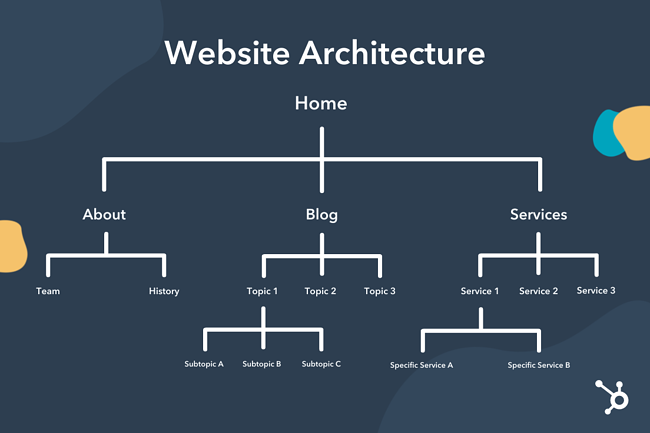
Below are a number of additional resources around information architecture (many of these are older resources, but the SEO principles outlined in them still largely hold true):
- Information Architecture for SEO from Moz’s Whiteboard Friday as well as Richard Baxter’s presentation on Moz
- RKG’s guide to site architecture
- KISS Metrics’ post on site structure
- WordTracker’s guide to creating a site structure Google will love
- Distilled has a helpful post about mapping out your site’s information architecture
SEO Basics Part 5: Content marketing and link building
Since Google’s algorithm is still largely based on links, having a number of high-quality links to your site is obviously incredibly important in driving search traffic: you can do all the work you want on on-page and technical SEO, if you don’t have links to your site, you won’t show up in search results listings.
There are a number of ways to get links to your site, but as Google and other search engines become more and more sophisticated, many of them have become extremely risky (even if they may still work in the short-term). If you are new to SEO and are looking to leverage the channel, these riskier and more aggressive means of trying to get links likely aren’t a good fit for your business, as you won’t know how to properly navigate the pitfalls and evaluate the risks. Furthermore, trying to create links specifically to manipulate Google rankings doesn’t create any other value for your business in the event that the search engine algorithms shift and your rankings disappear.
A more sustainable approach to developing links is to focus on more general, sustainable marketing approaches such as creating and promoting useful content that also includes specific terms you’d want to rank for and engaging in traditional PR for your business.
The process of creating and promoting content that will get you links and social shares is a labor-intensive one. Once again you’ll find more detailed step-by-step guides to various aspects of content marketing below, and there are a lot of different ways to effectively create content, help it to get discovered, and rank well in search results. Most approaches, however, will require you to walk through some variation of the following three core steps:
RELATED: How to Do an SEO Audit in 10 Easy Steps
1. Identify and understand your linking and sharing audience
The first thing you need to do in working to get traction for your content, is understand who is likely to link to and share your content. There are several tools to help you identify influencers within your niche who might share your content, but probably the most powerful is BuzzSumo:

Similar tools include FollowerWonk, Little Bird and Ahrefs. More detailed tutorials on using these tools to better understand your niche are included below.
The idea in leveraging these tools is to first identify the thought leaders and potential linkers in your space, and then understand what they share and link to. Find out what their problems are, what types of content they typically share, and start to think about how you can create something they would find valuable and want to share with their audience (who would also find it valuable).
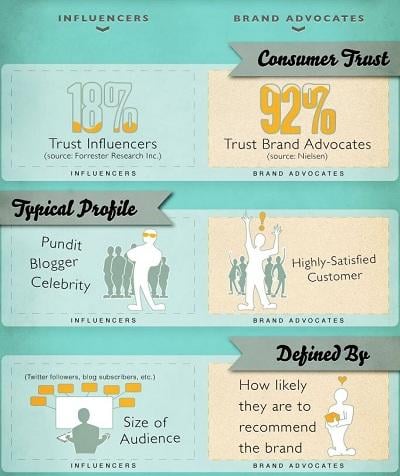
As you work through this process, start to think about what you can do for these influencers. How could you help them with their own projects? What can you do (unsolicited) that would help them achieve their own goals or what could you create or offer that would be of value to the audience they are creating content for and trying to help? Do you have access to unique data or knowledge that would help them do their jobs better? If you can consistently be of use to smart content creators in your niche, you’ll start to build powerful relationships that will pay dividends as you’re creating content.
Before you create a major piece of content, you should have already thought about how that content will get shared: who will share it, and why would they?
2. Determine what content you can create and how you can promote it
Next you have to try to understand what your own capabilities are, and what kind of content you can create that will be likely to be shared and promoted by others. A content audit may help with this.
A number of different types of content assets will be shareable:
- Create something that solves your prospects’ and your customers’ problems. In his post on how he built a top 100 blog, Matthew Woodward outlines a good process for listening in on social media and forums to help find great blog topics.
- Reverse engineer what already works. By looking at what already works and creating something that’s a level or two better in some way, you can help mitigate risk and make your content as fail-proof as possible.
- Make others look good. Highlight great tools you use every day. Get answers from smart folks in your niche to difficult questions and share that content (while positioning them as experts). When you’ve highlighted someone or their product as a valuable resource, they’ll be likely to help you share and promote that content.
Focus on creating different content assets that will be of real value, have a plan for promoting those assets, and don’t be shy about letting people who you’ve featured or whose audience would benefit from your resource know that it exists.
3. Map your assets to specific keywords
Finally, don’t forget about your keywords! This doesn’t mean that every time you create a great resource you need to cram in a keyword that doesn’t fit: it means that you can use keyword research as a means for discovering pain points (if people are turning to search engines to look for things, they want content that provides a great answer to their question!), and that as you create new assets you want to look for the different ways you can incorporate the language your prospects and customers are using into your assets: particularly those that will actually get linked to and shared (as you will increasingly need to get some sort of distribution for pages where you want them to rank for valuable keywords).
Additional Resources:
- 9 Free SEO Blog Post Templates Guaranteed to Drive Traffic
- How to Write an Awesome Blog Post in 5 Steps
- How to Find Your Target Audience
SEO Basics Part 6: Common technical SEO issues and best practices
While basics of SEO like the most efficient ways to build links to drive search engine rankings have changed in recent years (and content marketing has become increasingly important) what many people would think of as more “traditional SEO” is still incredibly valuable in generating traffic from search engines. As we’ve already discussed, keyword research is still valuable, and technical SEO issues that keep Google and other search engines from understanding and ranking sites’ content are still prevalent.
Technical SEO for larger, more complicated sites is really its own discipline, but there are some common mistakes and issues that most sites face that even smaller to mid-sized businesses can benefit from being aware of.
Are you making any SEO mistakes? Find out with the free LOCALiQ Website Grader.
Page speed
Search engines are placing an increasing emphasis on having fast-loading sites – the good news is this is not only beneficial for search engines, but also for your users and your site’s conversion rates. Google has actually created a useful tool here to give you some specific suggestions on what to change on your site to address page speed issues.
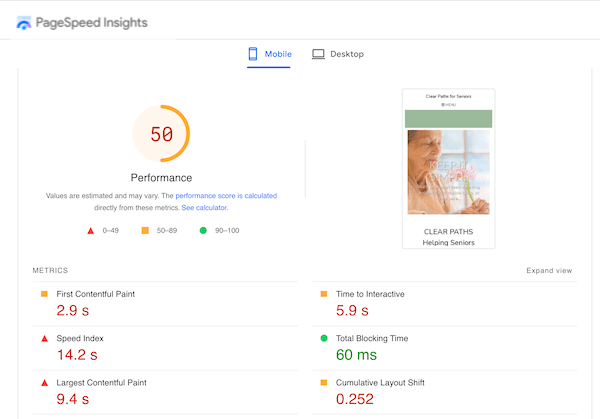
Mobile friendliness
If your site is driving (or could be driving) significant search engine traffic from mobile searches, how “mobile friendly” your site is will impact your rankings on mobile devices, which is a fast-growing segment. In some niches, mobile traffic already outweighs desktop traffic.
Google recently announced an algorithm update focused on this specifically. You can find out more about how to see what kind of mobile search engine traffic is coming to your site along with some specific recommendations for things to update in my recent post, and here again Google offers a very helpful free tool to get recommendations on how to make your site more mobile-friendly.
Header response
Header response codes are an important technical SEO issue. If you’re not particularly technical, this can be a complex topic (and again more thorough resources are listed below) but you want to make sure that working pages are returning the correct code to search engines (200), and that pages that are not found are also returning a code to represent that they are no longer present (a 404).
Getting these codes wrong can indicate to Google and other search engines that a “Page Not Found” page is in fact a functioning page, which makes it look like a thin or duplicated page, or even worse: you can indicate to Google that all of your site’s content is actually 404s (so that none of your pages are indexed and eligible to rank). You can use a server header checker to see the status codes that your pages are returning when search engines crawl them.
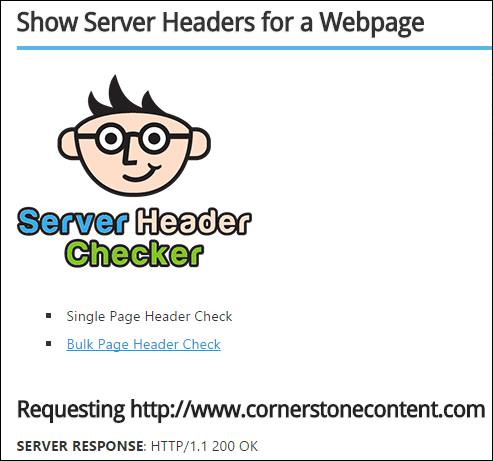
Redirects
Improperly implementing redirects on your site can have a serious impact on search results. Whenever you can avoid it, you want to keep from moving your site’s content from one URL to another; in other words: if your content is on example.com/page, and that page is getting search engine traffic, you want to avoid moving all of the content to example.com/different-url/newpage.html, unless there is an extremely strong business reason that would outweigh a possible short-term or even long-term loss in search engine traffic.
If you do need to move content, you want to make sure that you implement permanent (or 301) redirects for content that is moving permanently, as temporary (or 302) redirects (which are frequently used by developers) indicate to Google that the move may not be permanent, and that they shouldn’t move all of the link equity and ranking power to the new URL. (Further, changing your URL structure could create broken links, hurting your referral traffic streams and making it difficult for visitors to navigate your site.)
Duplicate content
Thin and duplicated content is another area of emphasis with Google’s recent Panda updates. By duplicating content (putting the same or near-identical content on multiple pages), you’re diluting link equity between two pages instead of concentrating it on one page, giving you less of a chance of ranking for competitive phrases with sites that are consolidating their link equity into a single document. Having large quantities of duplicated content makes your site look like it is cluttered with lower-quality (and possibly manipulative) content in the eyes of search engines.
There are a number of things that can cause duplicate or thin content. These problems can be difficult to diagnose, but you can look at Webmaster Tools under Search Appearance > HTML Improvements to get a quick diagnosis.
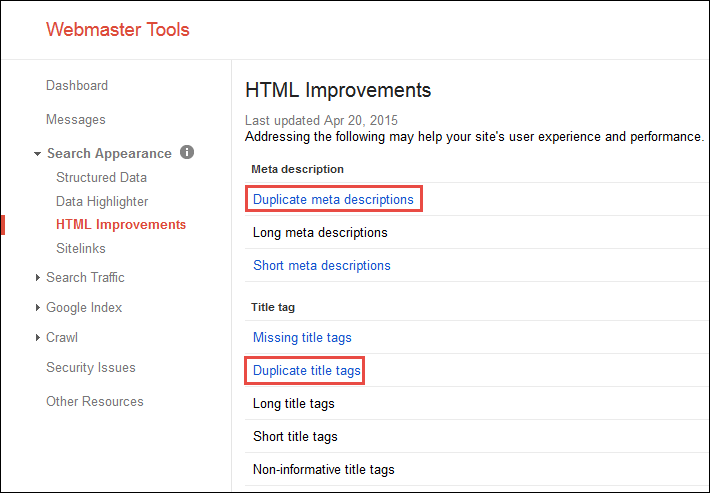
And check out Google’s own breakdown on duplicate content. Many paid SEO tools also offer a means for discovering duplicate content, such as Moz analytics and Screaming Frog SEO Spider.
XML sitemap
XML sitemaps can help Google and Bing understand your site and find all of its content. Just be sure not to include pages that aren’t useful, and know that submitting a page to a search engine in a sitemap doesn’t insure that the page will actually rank for anything. There are a number of free tools to generate XML sitemaps.
Robots.txt, meta noindex, and meta nofollow
Finally, you can indicate to search engines how you want them to handle certain content on your site (for instance if you’d like them not to crawl a specific section of your site) in a robots.txt file. This file likely already exists for your site at yoursite.com/robots.txt.
You want to make sure this file isn’t currently blocking anything you’d want a search engine to find from being added to their index, and you also can use the robots file to keep things like staging servers or swaths of thin or duplicate content that are valuable for internal use or customers from being indexed by search engines. You can use the meta noindex and meta nofollow tags for similar purposes, though each functions differently from one another.
Security
Site security is key for technical SEO. In addition to keeping your site maintained in terms of plugins and comment spam, you’ll also want to make sure your site is served over https, rather than just http. To do this, you need an SSL certificate. There are a number of ways to get one, such as through HubSpot’s SSL certificate.
Additional resources:
- Google gives some tips for creating your XML sitemap, as does Lunametrics
- These 11 free website graders that can help with technical and content SEO.
Technical SEO can be tough to do on your own, so if you’re thinking professional help is a worthwhile investment, check out this post on How to Find the Right SEO Services for Your Small Business
SEO Basics Part 7: How to track and measure SEO results
So once you start writing your awesome SEO content and putting all of these steps into motion, how do you actually track how well it’s working?
On its face this question has a fairly straightforward answer, with some key SEO metrics to focus on, but with each metric there are some key factors to consider as you measure your site’s SEO performance.
Keyword rankings
Looking at where your site ranks for a list of keywords certainly isn’t a final destination – you can’t pay your staff in rankings, things like personalization in search results have made them variable across different locations, and therefore hard to track, and of course all they indicate is where you show up in search results. Some would even go so far as to declare them dead. But getting a rough idea of where your site ranks for core terms can be a useful leading indicator of your site’s health. High rankings across a range of keywords is a strong indicator of organic search visibility.
This doesn’t mean you should get overly obsessed with rankings for any one term. Remember: your ultimate goal is to drive more relevant traffic that drives more business – if you sell blue widgets, is it more important that you rank for “blue widgets” or that you outline and execute an SEO strategy that helps you sell more blue widgets in the most cost-efficient way possible? Use rankings as a general health check, not a course-charting KPI.
A number of tools can help you check your rankings. Most offer fairly similar functionality but features like local or mobile rankings are sometimes unique in some of the tools. If you’re a small business or just getting started with SEO, I’d recommend picking a free and easy-to-use tool and just keeping an eye on a handful of the core terms you want to track to help you gauge progress.
Organic traffic
Organic traffic is a much better leading indicator of the health of your SEO efforts. By looking at the organic traffic to your site, you can get a gauge for the actual volume of visitors coming to your site, and where they’re going.
You can measure your organic traffic easily with most analytics tools – since it’s free and the most-used, we’ll look at how to get this information in Google Analytics.
For a quick check, you can simply look at your site’s main reporting page and click on “All Sessions” to filter for organic traffic (traffic from search engines that excludes paid search traffic):
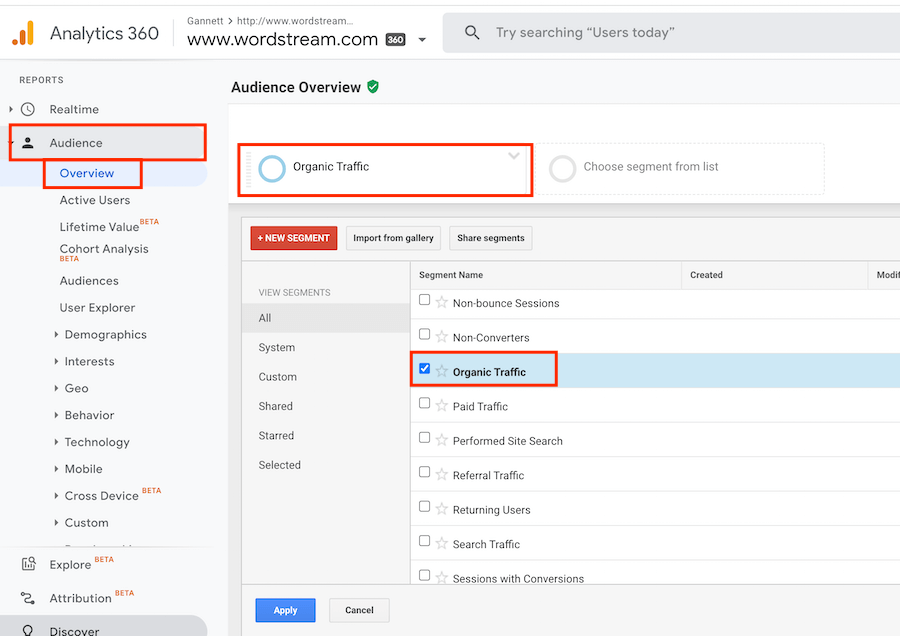
You can also drill down to look at the specific pages driving traffic and goals by creating a custom report and designating users and goal completions as your metrics, and landing pages as your dimension:
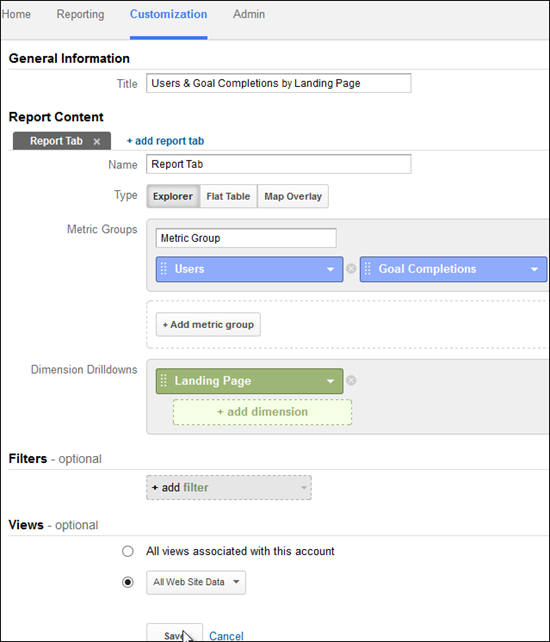
Note: Make sure once you view this report that you’re selecting the organic traffic segment again, or you’ll be looking at all of your traffic by page rather than just unpaid traffic driven by search engines.
This can be powerful for sites just getting started with SEO, because frequently most of your site’s traffic will be driven by what’s known as “branded queries,” or searches that contain your company’s brand name (for instance a branded search for WordStream might be “WordStream PPC” versus a non-branded search term, which might be “pay-per-click software”). You clearly want to have people searching for your brand, and of course you want them to find you when they do, but unless your site has been penalized by Google, you will almost certainly rank for your brand and have that branded traffic come to your site’s home page. What most of your ongoing SEO efforts should be centered around is driving incremental traffic to the site (people who might not have found and engaged with you otherwise).
As I mentioned in the keyword section of the guide, unfortunately Google has made it difficult to get data around the actual keywords people are searching for, but by looking at page-level traffic (outside of your site’s home page) you can start to glean insight into your overall SEO progress. Looking at rank data and using the tactics mentioned in the keyword section of this guide will also help you to get more insight into the actual terms that are driving traffic (and whether your SEO growth is being driven by optimization efforts rather than off-line marketing).
RELATED: The Complete Website Audit Checklist (in One Epic Google Sheet)
Organic leads and sales
Obviously the primary way to measure your search engine optimization results should be actual leads, sales, revenue and profit. Like with any business activity you need to answer: how does the activity help to move your bottom line?
The simplest path here is to set up goals or e-commerce tracking in a tool like Google Analytics. You can use the above report to look at organic traffic and goals (or different e-commerce metrics) by landing page, which means that you are specifically looking at who converts among the people who are landing on your site from an organic search (versus people who may have come to your site from PPC or another channel within the window that your analytics tracking can track, then searched for you, then converted).
This seems pretty straightforward, and generally for most businesses is a good initial way to measure the success of your SEO efforts, but again there are a few caveats and things to keep in mind with this data:
- Web-based analytics is always imperfect. If you’re transitioning from billboards or newspaper ads to online marketing, you’ll likely be impressed by the volume and precision of the data available, but there can frequently be a variety of different tracking issues that can make the data you’re seeing anywhere from slightly to wildly off – always have a degree of skepticism about data that doesn’t seem to add up, and do what you can to have some checks in place to make sure that your analytics information is synced to your actual revenue and spend data.
- Your system might create gaps in tracking. If you have a back-end system that you can’t quite tie to analytics for some reason, you might have some gaps between what you can track as goals and actual sales.
- Attribution and life-time value metrics can be tricky. This is more of a business and web metrics problem than something specific to SEO, but figuring out how you attribute sales to different channels and factoring in life-time value to your site’s traffic can be tricky. Make sure you’re applying the same types of tough questions and attempting to measure SEO the same way you would with any other marketing endeavor.
- You can learn more about multi-channel attribution in Avinash Kaushik’s in-depth guide
- KISS Metrics offers a nice overview of cohort analysis and multi-touch attribution
- Omniture is a popular paid web analytics platform that can have a steep learning curve – these two resources offer some good tips to creating useful SEO reports
Free guide >> 25 Ways to Increase Traffic to Your Website
Additional resources
- You can learn more about multi-channel attribution in Avinash Kaushik’s in-depth guide
- KISS Metrics offers a nice overview of cohort analysis and multi-touch attribution
- Omniture is a popular paid web analytics platform that can have a steep learning curve – these two resources offer some good tips to creating useful SEO reports
SEO Basics Part 8: Additional SEO considerations
For many businesses, getting the technical aspects of SEO right, understanding the keywords you want to target, and having a keyword strategy for getting your site’s pages linked to and shared is really all you need to know about SEO. There are, however, some specific cases and business types that need to be concerned with specific types of search. A few types of search environments that require unique approaches include:
- International SEO – There are a number of benefits and trade-offs to different approaches to ranking sites in different countries and in different languages. Aleyda Solis has an outstanding guide to international SEO best practices if you’re trying to reach customers in a variety of international markets, and Google also offers some recommendations and best practices in their own guide.
- Local SEO – For small businesses and franchisees, getting local rankings for different variations of {your location} + {your service} (e.g. “Boston pizza shops”) is really the most valuable organic search traffic available. While getting links and shares, doing keyword research, and ensuring your site doesn’t have technical issues helps with localized rankings, there is a separate set of ranking factors local businesses should be aware of. Matthew Barby has an excellent guide on the topic.
- App Store Search Engines – If you have an app – either as the core product offering for your company, or as a means for enabling mobile users to be able to interact with your business – having your app show up in searches on various app stores can be extremely valuable. Justin Briggs and Stephanie Beadell have written multiple outstanding posts on the topic.
SEO Basics: Recap and next Steps
Alright, so the SEO basics are:
- Understanding the importance of SEO
- Keyword research and targeting
- On-page optimization
- Information architecture
- SEO content and link building
- Technical SEO
- Tracking and measuring SEO results
- SEO miscellaneous (mobile, international, local)
So if you’ve gotten this far, you should know a lot of information about how search engines rank websites and about how you can position your own site and business to generate more search traffic from search engines like Google. What should you do next?
Prioritize. No site does a perfect job of executing against every single aspect of search engine optimization. Think about the things you do well, have budget and resources for, and that will give your business the best return for your investment – this will be at least slightly different for every business and site.
If you’re great at creating and promoting content, determine which keywords to go after and focus your efforts there.
If you have a large and complex site, focus on getting the technical SEO right (or hire someone who can).
If you’re a small business that would benefit from ranking for very specific geo-focused terms but not much else, shore up your local SEO efforts (and then maybe focus on other marketing efforts once you start to see diminishing returns from your efforts there).
Always remember that the ultimate objective with any search engine optimization efforts is to get more exposure and traffic for your business or your site’s content. Look for ways that search engine traffic can help your business and site: don’t just chase after the latest SEO buzzwords or jump every time Google makes a recommendation that might improve your search rankings while hurting your overall business.







